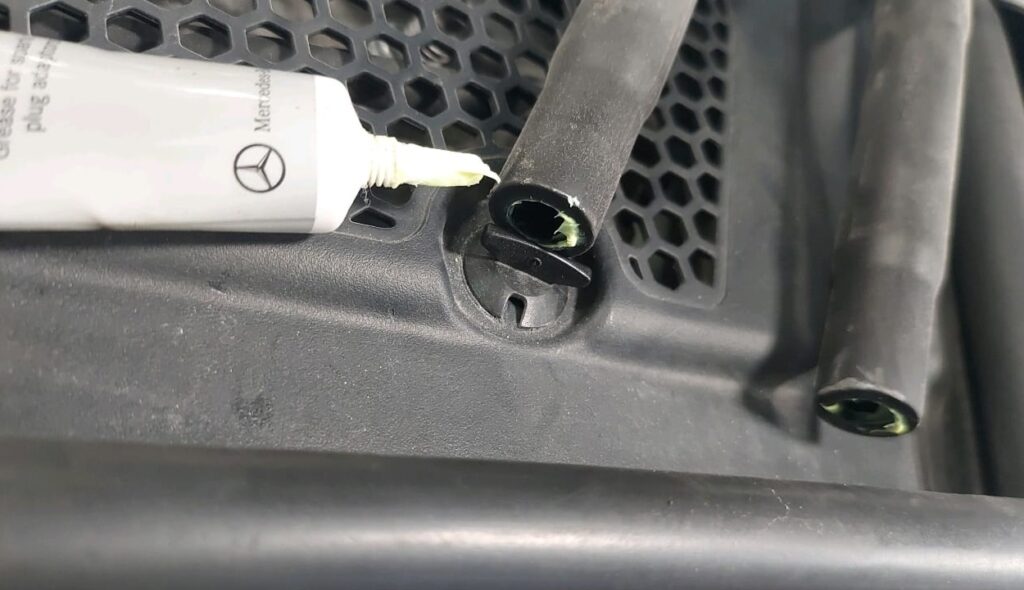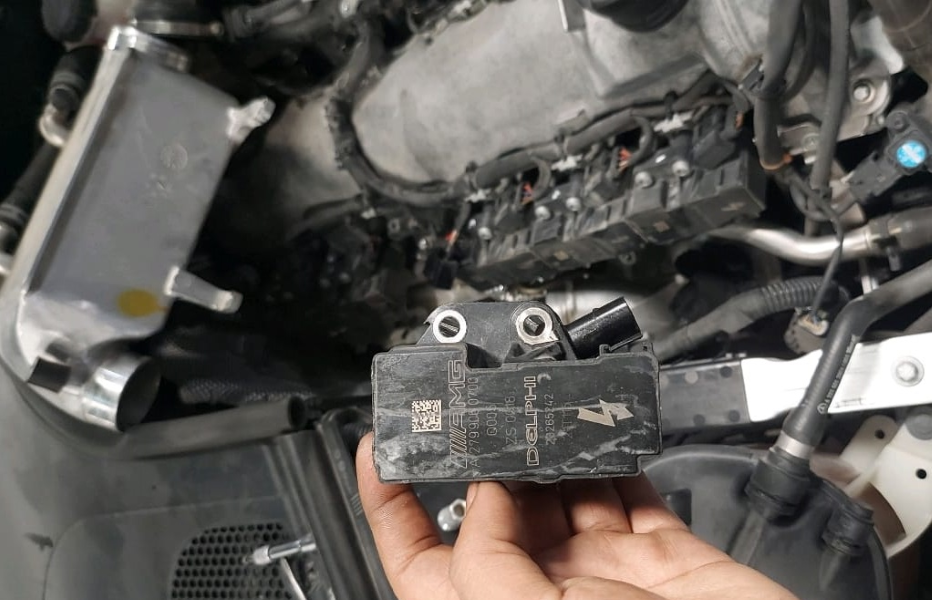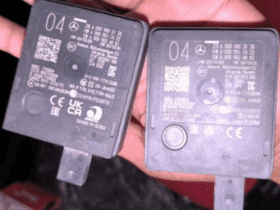Table of Contents
How To Fix Engine Misfire in a Mercedes-Benz Maybach S680 Equipped with M279 V12 Engine
The Mercedes-Benz Maybach S680 is the pinnacle of luxury and engineering, powered by the M279 6.0L twin-turbocharged V12 engine. Known for smoothness and unmatched performance, this powerhouse rarely shows weakness. But like any complex engine, it can experience issues one of the most concerning being an engine misfire.
Engine misfires can reduce performance, trigger the check engine light, and even cause long-term damage if ignored. In this case study, we’ll walk through the real-world diagnosis and repair of a misfire in a Maybach S680, focusing on how a faulty ignition coil in cylinder four was identified and replaced.
Vehicle Overview
- Model: Mercedes-Benz Maybach S680
- Engine: M279 6.0L V12
- Customer Complaint: Check engine light on + noticeable engine misfire

Symptoms Reported by the Customer
When the Maybach arrived at the workshop, the customer described two key issues:
- – Check engine light was illuminated.
- – The vehicle had a distinct engine misfire, affecting driving smoothness.
These symptoms suggested a potential ignition or fuel delivery fault requiring immediate attention.
Step-by-Step Diagnostic Process
1. Diagnostic Scan
Using the Mercedes-Benz Star Diagnostic (Xentry) system, a scan of the ME (Motor Electronics) control unit was performed.
- – Finding: Fault code flagged an open circuit in the ignition coil of cylinder four.
- – Conclusion: Strong indication that the ignition coil was defective.
2. Physical Inspection of Ignition Components
Even with electronic evidence, a physical inspection is critical.
- – Wiring: Checked for cuts, shorts, or disconnected plugs leading to cylinder four.
- – Connectors: Ensured terminals were secure and corrosion-free.
- – Spark Plugs: Inspected spark plugs for fouling or wear ruled out as the cause.
- – Ignition Coil: Cylinder four coil showed signs of internal failure.

3. Live Data Monitoring
The engine was run while monitoring live misfire counters and ignition data.
- – Misfires were isolated to cylinder four.
- – Fuel injection and air-fuel ratios were normal.
- – Confirmed that the ignition coil failure was the root cause.
4. Replacing the Defective Ignition Coil
The faulty ignition coil in cylinder four was replaced with a genuine OEM Mercedes part.
- – Removed old coil and inspected seating.
- – Installed new ignition coil.
- – Cleared fault codes and reset adaptations.



Final Checks & Test Drive
- – Re-scanned: No fault codes remained in the ME unit.
- – Engine test: Ran smoothly with no misfire detected.
- – Road test: Confirmed smooth acceleration, restored power, and no CEL illumination.
Result: Misfire resolved by replacing the ignition coil.
Symptom – Cause – Fix Table
| Symptom | Likely Cause | Fix |
|---|---|---|
| Rough idle + CEL on | Faulty ignition coil | Replace defective coil with OEM part |
| Misfire in one cylinder only | Spark plug wear or fouling | Replace spark plug, check gap |
| Hesitation under load | Fuel injector fault | Clean or replace injector |
| Multiple misfires | Vacuum leak or fuel pressure issue | Inspect intake hoses, test fuel system |
| Persistent misfire despite repairs | Mechanical issue (compression loss) | Perform compression/leak-down test |
Explore More Mercedes Engine Misfire Issues
For a deeper dive into all misfire-related problems, visit our hub page: Mercedes Engine Misfire Issues – Causes and Fixes. You’ll find grouped case studies, step-by-step diagnostics, symptom–cause–fix tables, and prevention tips to help you resolve misfire problems quickly and effectively.
Preventive Tips for Avoiding Misfire in the M279 Engine
- – Replace spark plugs at recommended intervals (around every 60,000 miles or 4–5 years).
- – Inspect ignition coils during routine service, especially in high-mileage V12 engines.
- – Use premium fuel to avoid carbon buildup.
- – Monitor check engine lights immediately rather than ignoring them.
- – Schedule diagnostic scans to catch early misfire activity.
How Do You Fix a Misfire Caused by an Ignition Coil?
Fixing a misfire due to a coil is straightforward:
- 1. Diagnose the Problem: Scan for misfire codes (e.g., P0304 for cylinder 4).
- 2. Access the Coil: Disconnect the battery, remove engine covers, and locate the faulty coil.
- 3. Remove the Coil: Unplug the connector, unscrew bolts, and extract the coil.
- 4. Install New Coil: Place the new OEM coil, secure it, and reconnect wiring.
- 5. Clear Codes & Test: Reset the ECU, start the engine, and verify misfire is gone.
- 6. Test Drive: Confirm smooth running in real driving conditions.
Can a Misfiring Engine Be Fixed?
Yes. An engine misfire is repairable once the root cause is identified. Common culprits include:
- – Worn spark plugs
- – Faulty ignition coils
- – Fuel injector malfunctions
- – Vacuum leaks
- – Sensor failures (MAF, O2, camshaft position)
- – Low compression due to internal wear
The key is accurate diagnosis followed by component-specific repair.
Is an Engine Misfire Expensive to Fix?
Repair costs vary depending on the cause:
- – Spark plugs: €100–€300
- – Ignition coil: €200–€400
- – Fuel injectors: €400–€800 each
- – Serious engine repairs (rings, gaskets): €1,500–€2,500+
Tip: Early diagnosis keeps costs lower. Ignoring a misfire can damage the catalytic converter, increasing repair bills.
FAQs on Mercedes-Maybach Misfires
Q1: What causes a misfire in a Mercedes-Maybach S680?
Most commonly, worn spark plugs, failing ignition coils, or injector issues.
Q2: Can I drive a Maybach with a misfire?
Not recommended. Misfires reduce performance and risk damaging the catalytic converter.
Q3: How often should ignition coils be replaced?
There’s no fixed interval, but coils are often replaced around 100,000 km, especially if misfires occur.
Q4: Does the M279 V12 require special spark plugs?
Yes. Always use OEM double platinum or iridium spark plugs for durability and performance.
Q5: Is the diagnostic process different for a V12 engine?
The principles are the same, but with 12 cylinders, precise diagnostic tools (Xentry + oscilloscope) are essential to pinpoint faults.
Conclusion
Fixing an engine misfire in the Mercedes-Benz Maybach S680 with the M279 V12 engine requires precision and the right tools. In this case, the misfire was traced to a faulty ignition coil in cylinder four, confirmed by diagnostics and physical inspection. Replacing the coil restored performance and eliminated the misfire.
For owners, the lesson is simple: address misfires immediately. For technicians, the takeaway is to follow a systematic approach scan, inspect, test, and replace. With proper maintenance and timely repairs, the M279 engine continues to deliver the smooth, powerful performance expected from a Maybach.
Author
Written by: Mercedes Expert
Automotive Technical Trainer & Mercedes-Benz Diagnostic Specialist
With years of hands-on experience repairing and diagnosing Mercedes-Benz vehicles, specializes in case-study-based troubleshooting guides that blend workshop accuracy with educational clarity.
Last Updated: September 2025
— Salim, Mercedes Expert
Independent specialist in Mercedes-Benz diagnostics, CAN Bus analysis, troubleshooting case studies, and EV systems.







Leave a Reply